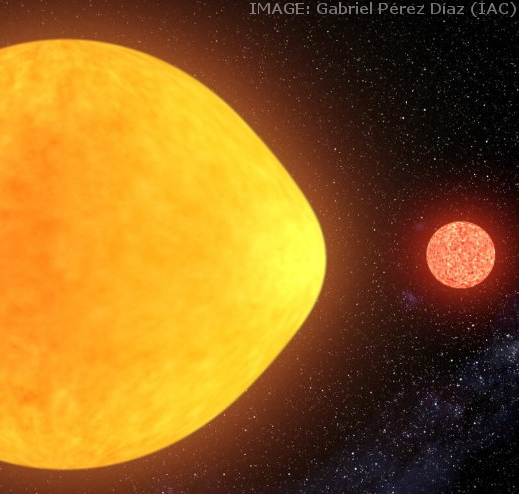New star pulse spotted

An international team has discovered a star that pulsates on just one side.
The star, located in the Milky Way about 1,500 light years from Earth, is known as HD74423 and weighs close to 1.7 times the mass of the Sun.
Stars that pulsate have been known in astronomy for a long time. Our own Sun creates its own rhythms. These rhythmic pulsations of the stellar surface occur in young and old stars, and can have long or short periods, a wide range of strengths and different causes.
There is however one thing that all these stars have thus far in common: the oscillations are always visible on all sides of the star.
It now appears that stars can oscillate largely over one hemisphere, and scientists say they have identified the cause of such unusual single-sided pulsation.
The star is located in a binary star system with a red dwarf. Its close companion distorts the oscillations with its gravitational pull.
The orbital period of the binary system, at less than two days, is so short that the larger star is being distorted into a tear-drop shape by the gravitational pull of the companion.
To their surprise, the team observed that the strength of the pulsations depended on the aspect angle under which the star was observed, and the corresponding orientation of the star within the binary. This means the pulsation strength varies with the same period as that of the binary.
“As the binary stars orbit each other we see different parts of the pulsating star,” said Dr David Jones at the Instituto de Astrofisica de Canarias and co-author of the study.
“Sometimes we see the side that points towards the companion star, and sometimes we see the outer face.”
This is how the astronomers could be certain that the pulsations were only found on one side of the star, with the tiny fluctuations in brightness always appearing in their observations when the same hemisphere of the star was pointed towards the telescope.
The clue that led to its discovery came from citizen scientists poring over public data from NASA’s TESS satellite, which is hunting for planets around distant stars. These amateur astronomy sleuths painstakingly inspected the enormous amounts of data that TESS regularly supplies, as they search for new and interesting phenomena.
While this is the first such star to be found where only one side is pulsating, the authors believe there must be many more such stars, which will be spotted as technology to listen inside the beating hearts of stars improves.
“We’ve known theoretically that stars like this should exist since the 1980s,” said co-author Professor Don Kurtz from the University of Central Lancashire in Britain.
“I’ve been looking for a star like this for nearly 40 years and now we have finally found one,” said Professor Kurtz from the University of Sydney.
The international research team has published its findings in Nature Astronomy.








 Print
Print